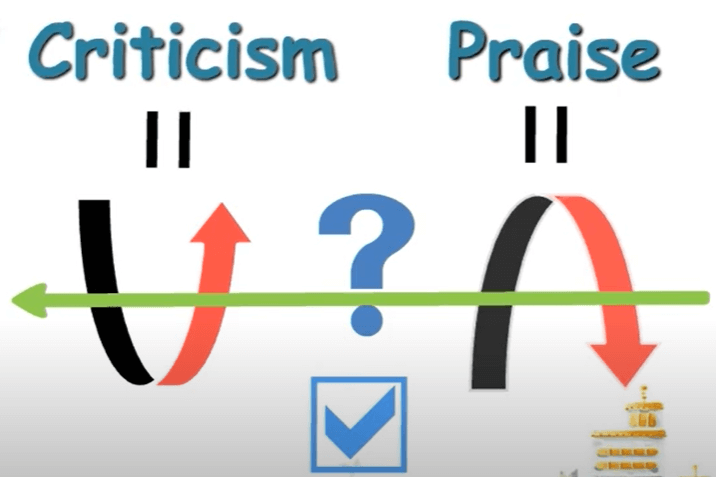Most of the people believe that criticism is a good thing, that it helps a person to perform better the next time. Praise, however, works the other way around. Is criticism really more effective than praise?
Moving forward, we are going to unlock one of the greatest misinterpretation of human experience.
What we believe our experience has taught us?
Nobel Prize winning economist Daniel Kahneman was giving a lecture about the psychology of effective training to the Israeli Air Force. One of the officers shared an experience that praising his subordinates led to their worse performance, whereas scolding led to an improvement in subsequent attempts. As a consequence, the officer had grown to be generous with criticism and was extremely cautious while giving too much praise.
Most of us are like the officer. We believe that our experience taught criticism to be more effective in producing better results than praise, i.e. criticism is often followed by an improved performance and praise is often followed by a performance that is not as good. So, we think that praise might be nice and sometimes we need to do some of it, but when it actually comes to improving people’s performance, criticism is the key.

Unfortunately, this is one of the areas where lessons of human experience are not obvious, and can even be misleading sometimes. Our observation that criticism is often followed by an improved performance and praise is often followed by a declination is probably accurate, but what’s going on is not what we think. Rather, it is something called Regression to the Mean.
And if we do not understand it, we and the people we care about will be its victims.
Regression to the Mean
After hearing the officer’s story, Kahneman immediately recognized that it was regression to the mean at work. Then, he illustrated a simple experiment.
He drew a small circle on the blackboard, and asked the officers to throw the chalks targeting the circle with their backs facing the blackboard. He recorded the performance of each officers for two trials. The result?
Those who performed better at the first trial tended to do worse on the second trial, and vice versa. It was a moment of enlightenment for everyone : the change in performances occurs naturally. Kahneman termed this phenomenon Regression to the Mean.
To better understand it, consider the figure shown below:

If the red line is the average or the mean, then the trend oscillates up and down around it. The trend moves above the average and regresses back towards it. Then the trend moves below the average, and again regresses to the mean, often continuing to overshoot up and down.
This phenomenon of the trend tending to return back to the mean value is called Regression to the Mean.
Example : Heights of Fathers and Sons
The theory of regression was first developed by a British polymath Sir Francis Galton.
He studied the heights of groups of fathers and their sons. He grouped the fathers into two categories, tall and dwarf, and calculated their average height. When he studied the heights of fathers and sons he found that the taller fathers have taller sons, and dwarf fathers have dwarf sons.
Then he found something really interesting !

The average height of the sons of the taller fathers was less than the average height of the taller fathers, and the average height of the dwarf sons was greater than the average height of the dwarf fathers.
A careful thinking leads us to a remarkable conclusion : irrespective of the production of new offspring, the average human height remained a constant, i.e. regressed to the mean !
Relation with Performance
Now we know the concept of regression to the mean. So, how is it related to our performance?
Human performance is never completely consistent. It is true of a student, a lecturer, an executive, a singer, a dancer, a guitarist, a sportsman, you, me and everyone around us.
No one performs at their best or worst every day. We all know this, and it is why we assess the greatness of a football player not by his performance in a single game, but in a whole season or even a whole playing career. In order words, we look at the player’s average performance overtime, or to use the statistician’s term, his ‘mean’ performance.
Now, consider some moderately difficult task performed by someone, say your sister. Assume that her skills and strengths are not reinforced over the period.
You begin monitoring her work and giving her either positive or negative feedback, i.e. praise or criticism after every performance.
We know that her performance varies around the mean. So, when she performs worse than average, she most likely will perform better the next time even if you say or do nothing because her performance will naturally move or regress towards her mean or average level. However, since you criticized her performance, you will mistakenly conclude that she improved because of your criticism.

In the same way, when she performs above her mean level, she most likely will perform worse the next time even if you say or do nothing because, again, her performance is regressing to the mean. But, because the poorer performance followed your praise, you will again mistakenly conclude that it was caused by a praise.
We may not be aware of these apparent connections consciously, but if we honestly explore our inner thought processes, we realize that we are aware of them intuitively.
Conclusion
So what do we get from this is criticism is, in fact, a bad recipe for inspiring someone to improve their work. If we really want better results, then we need to identify and build on skills and strengths.
So, do you still say your experience has taught you criticism is more effective than praise? I guess, not.

From now on, do not ever be mislead by your experience. Its real lessons are not always obvious, and finding them often requires thought, reflection and analysis.
Thank you so much for taking your invaluable time to read this blog. The idea of regression to the mean applied to performance was adopted from Daniel Kahneman‘s book Thinking, Fast and Slow.
To better grasp the concept from whiteboard animation, check out the following video:
Was it helpful?
Mention in the comments below.
Do not forget to check our other blogs, and research paper summaries.







